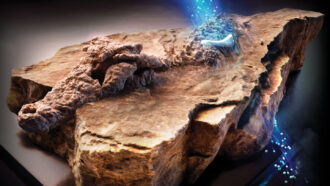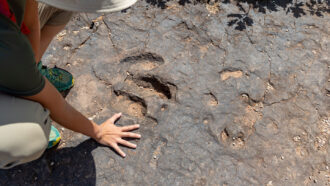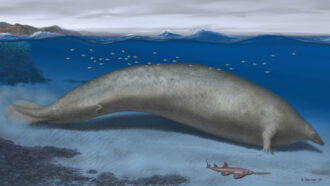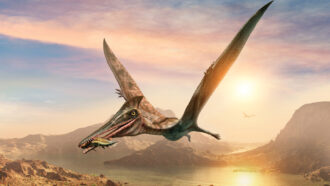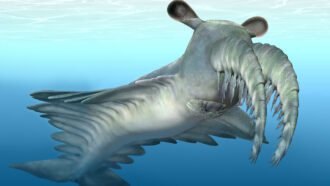Mini tyrannosaur fills big evolutionary gap
This deer-sized T. rex relative shows how quickly tyrannosaurs got big
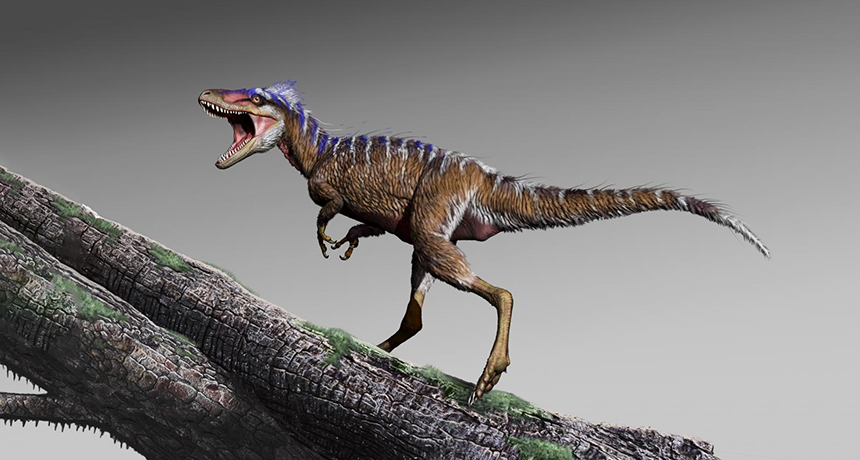
About the size of a deer, the newly discovered Moros intrepidus (illustrated) is one of the smallest tyrannosaurs known.
Jorge Gonzalez, © L. Zanno
By Jeremy Rehm
Even the giant Tyrannosaurus rex had humble beginnings. A new fossil shows that an early ancestor was only about the size of a deer. Its discovery helps fill a 70-million-year gap in the evolution of giant tyrannosaurs such as T. rex.
Lindsay Zanno is a paleontologist at North Carolina State University in Raleigh. She and her colleagues dug for 10 years around Emery County in Utah. They were searching for clues to solve a longtime dino mystery: When and how did tyrannosaurs get their famous bulk?
Early tyrannosaurs were much smaller. Teeth from petite species have been found in rocks in North America dating to around 150 million years ago. At that time, in the Late Jurassic Period, large allosaurs topped the food chain. The next time tyrannosaurs showed up in the North American fossil record was 70 million years later, during the Cretaceous Period. By then, they had become the colossal top predators best known today.
Zanno and her team were looking for clues to what happened in between when they found a long, thin leg bone. It dated to around 96 million years ago. They determined the fossil came from a new species of tyrannosaur. It’s the oldest one known from the Cretaceous. They named the species Moros intrepidus, or “omen of doom.”
M. intrepidus is one of the smallest tyrannosaurs from the Cretaceous. Analyses of the fossil leg show it would have stood about 1.2 meters (4 feet) tall at the hip. It probably weighed about 78 kilograms (172 pounds). That’s about the size of a mule deer. The find was described February 21 in Communications Biology.
The bone’s long, thin shape suggests M. intrepidus was a swift runner. Later titanic tyrannosaurs were likely far less speedy.
“What Moros shows is that the ancestral stock of the big tyrannosaurs was small and fast,” says Thomas Carr. He studies tyrannosaurs at Carthage College in Kenosha, Wis. He wasn’t part of the new study. But the new fossil also suggests something big — literally — happened after Moros, Carr says. “The tyrannosaurs became giant sometime in that 16-million-year stretch” between Moros and T. rex, he notes.
The researchers used traits of the new fossil to see where M. intrepidus fit into the tyrannosaur family tree. They determined that M. intrepidus came from Siberia in Asia. It could have reached modern-day Alaska when sea levels were low, the authors say. Many other animals followed a similar route from Asia. That great migration included mammals, lizards and other dinosaurs.
The Cretaceous Period’s warming climate probably killed off the allosaurs, Zanno says. But not the tyrannosaurs. “They rapidly increase in size and go on really quickly to become the dominant predators,” she says.
M. intrepidus leaves plenty of questions about how tyrannosaurs evolved. “It’s great that [the new fossil] helps fill in part of the history,” says Thomas Holtz Jr. He’s a tyrannosaur expert at the University of Maryland in College Park. Scientists still need to find the rest of the skeleton for M. intrepidus. Other tyrannosaurs from the gap between M. intrepidus and its giant descendants could help pinpoint when the creatures exploded in size.
Concludes Holtz: “The story of tyrannosaurs is definitely not over.”


